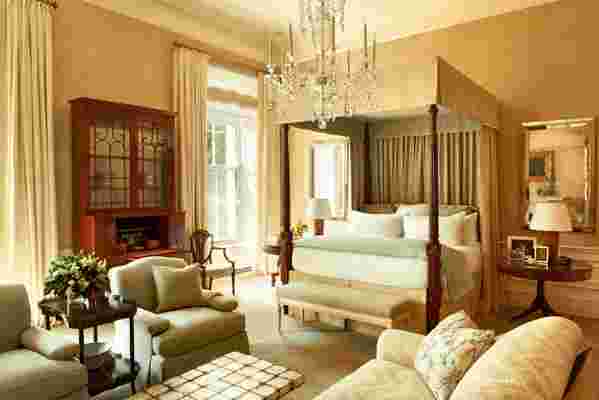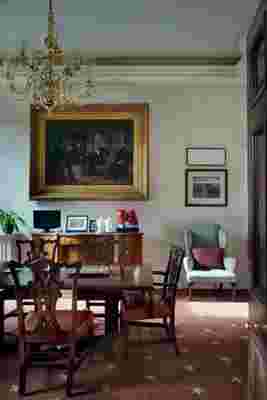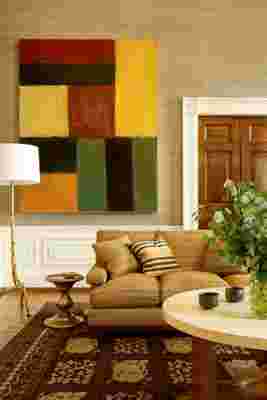Peek Inside the Obama Family’s White House
From the line cooks to the housekeepers, discretion is of the utmost importance when working for the president of the United States of America. Like most who have conducted business at 1600 Pennsylvania Avenue, Michael S. Smith has remained relatively tight-lipped about the details of his time there, choosing to keep his most personal stories close to the vest. Still, there are plenty of tantalizing tidbits for the aesthetically astute in a new book about the AD100 designer’s carefully studied refurbishment of the White House’s private quarters and public spaces during the Obama family’s tenure. Among them: Don’t even talk to President Obama about using plates as decorations—he has stated on more than one occasion that he’s not a fan. Also worth noting is the revelation that a seven-year-old Sasha Obama may have found the secret to making the perfect bed (just sleep on one side so the morning tidying is quick and easy).
But a tell-all this is not. At its heart, Designing History: The Extraordinary Art & Style of the Obama White House ( Rizzoli, September 1 ) is a love letter to the rich and endlessly fascinating layers of an architectural icon as much as it is a testament to President and Mrs. Obama’s assiduous stewardship of a place that stands at the center of the American experience. It’s also the diary of one family’s desire to carve out a happy home that felt like a sanctuary in the most glaring of public spotlights.

The Main Bedroom offers a sunny view of leafy trees and the wide South Lawn below. The high-post bed is early-19th-century American, and its canopy, curtains, and bed skirt are of a Larsen raw silk. The embroidered pillow in the foreground is by Jed Johnson Home, and the wallpaper is by Gracie; the rug was custom-made by Mitchell Denburg.
“I was always very conscious that the Obamas were a dynamic but actually super-normal young family that had been placed in extraordinary circumstances,” Smith writes in the preface to the book, which was cowritten with Margaret Russell and includes a foreword by Michelle Obama herself. “I had to balance the logistics of creating a comfortable home for them within the context of not only this historic house, but their historic presidency, where every decision, large or small, was driven by their uncommon mindfulness. The Obamas were my constant inspiration, and their mission to celebrate the White House as the People’s House, a place that was welcoming and accessible to all Americans, led to our focus on highlighting the best of America in every possible way—through not just the diversity of creative talents, but the diversity and richness of culture—from painting and sculpture to the craft of furniture, textiles, ceramics, and more.”

In President Obama’s Private Dining Room, George P. A. Healy’s The Peacemakers , an 1868 painting depicting Civil War peace negotiations, is displayed on the far wall, above a pair of Muhammad Ali’s boxing gloves autographed “to Barack”; to the right are framed notes from a speech by JFK and a seascape painted by Senator Edward M. Kennedy.

In the Family Sitting Room, Sean Scully’s painting ONEONEZERONINE RED , on loan from the National Gallery of Art, is displayed against a wall clad in a rush-cloth paper by Crezana. The sofa is by Roman Thomas, the side pedestal table and travertine-top table are by Jasper Furniture, and the rug is by Mansour.
There are chapters dedicated to each room’s light-handed reinvention—Smith and Mrs. Obama were adamant about using pieces that had historical resonance both in terms of style and function, and that any change made would be beneficial to future first families and White House staff—with behind-the-scenes insights about everything from color and fabric choices to the selection of strikingly contemporary art, which Smith used to modernize the spaces. And there are more than a few aha moments: Smith includes anecdotes about how he added a border trim to remedy Bush-era curtains that shrank during cleaning (who hasn’t been there?), and how he lit some of the darker spaces with LED lighting to give them greater functionality in the face of two children who had homework to do in the White House’s historic halls.
But while the book chronicles some of the trials and tribulations of orchestrating deliveries and installations in one of the most secure locations in the world, Smith mostly relishes his role as chief historian of the White House’s architectural legacy. As preparation for the seemingly impossible job of decorator-elect, he pored over biographies of first ladies and made late-night phone calls to Nancy Reagan to learn as much as he could about the hurdles he’d need to clear in the lead-up to the inauguration in 2009 (one bit of advice included ordering curtains for the upstairs rooms well in advance).
The Solarium is wrapped by windows and faces south, offering a spectacular view of the Washington Monument.
“It’s like building a ship in a bottle,” Smith tells AD of the small movements and inordinate amount of thought that went into every decision. “You’re mindful of making sure everything you do fits within the context of the room and a very busy family. Mrs. Obama and I were really committed to this idea of coloring in between the lines, especially in the public spaces.” But with her blessing, Smith took greater liberties in the first daughters’ bedrooms. “It’s always interesting to take something that seems so still and static and insert children into it,” he says, as images of Malia and Sasha’s rooms jump from the pages with their vibrant rugs and brightly patterned textiles. “It added a really fun component to the whole process.”
Smith created a few seating areas in the Second Floor Center Hall, using classic 1960s-style upholstery, antiques, and a midcentury coffee table; Hans Hofmann’s Staccato in Blue is displayed on the far wall and White Line, by Sam Francis, hangs in the foreground, both on loan from the National Gallery.
Though many of the White House interiors Smith has made over have become ingrained in the American psyche by nature of their role as the very public backdrop to some of the last decade’s most newsworthy events, he is quick to point out that the rooms are meant to evolve. “When you’ve done something so intense, you’re conscious of the fact that you’re not going to be in it forever,” says Smith of his eight-year collaboration with President and Mrs. Obama and what other families may have in store for it. “When you leave, it’s a much more extreme situation than having done a house for a client. Rather than looking back, I continue to look forward with an eye toward the future.” One can only assume he’s referring to spaces within the forthcoming Barack Obama Presidential Library in Chicago. But, loyal friend and confidant that he is, he’s not spilling the beans anytime soon.
Designing History: The Extraordinary Art & Style of the Obama White House will be available online and in bookstores on September 1.
Cover of Designing History: The Extraordinary Art & Style of the Obama White House, by Michael S. Smith with foreword by Michelle Obama (Rizzoli, September 2020).